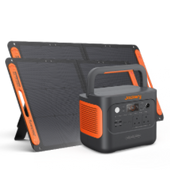Wales is known for its changeable climate and frequent storms. Storms profoundly impact people's daily lives and cause substantial economic losses and ecological damage. Therefore, residents in Wales need to know how to respond during storms.
In particular, the recent storm Darragh has profoundly impacted Wales and the UK in many aspects. From damage to the power supply system to traffic disruptions to threats to social order and public safety, this storm has brought considerable challenges to Wales.
This guide will provide an overview of storm Darragh and strategies to prevent storm damage. Storms usually result in power outages, and electricity is far more important during those times, especially in winter. So, a Jackery Portable Power Station—a portable power supply to charge your essential appliances—is a wise choice in a storm or other emergency.
|
Key Takeaways: |
|
- Storms usually have a significant impact on human life and society. - After Storm Darragh hit most parts of Wales, about 57,000 households and businesses were still without power. A rare red gale warning was issued in Wales and southwest England, and gusts of more than 90 miles per hour were recorded in many places. - Wales is located in the west of the United Kingdom and is influenced by the Atlantic Ocean all year round. The weather in Wales is highly changeable. - There are many tips to prepare for a storm, such as noticing the weather warnings, making an emergency plan, packing the emergency kit, and more. - We recommend Jackery Explorer 1000 v2 or 2000 Plus as your solar backup generator for charging appliances during an emergency or power outage. |
Storm Darragh Overview
Storms not only bring strong winds and heavy rains but also cause a series of severe disasters that profoundly impact society and the economy. So, what exactly is a storm?
What Is a Storm?
A storm is a strong weather phenomenon usually accompanied by natural phenomena such as strong winds and heavy rains. It has a significant impact on human life and society.
A storm is a manifestation of atmospheric disturbance, usually accompanied by strong winds, precipitation and other extreme weather phenomena. It can be local, such as thunderstorms, tornadoes, large-scale tropical cyclones or extratropical cyclones.
Storms cause direct material losses and may trigger a series of secondary disasters, such as floods and mudslides. Therefore, strengthening storm monitoring and early warning and formulating effective defence measures are crucial to mitigate their impact.
What Harm Does a Storm Bring?
A storm's harm is usually multifaceted, including floods, wind damage, traffic disruptions, infrastructure paralysis and secondary disasters.
|
Storm Hazards |
|
|
Floods |
Strong winds and rainstorms produce a large amount of precipitation in a short period, exceeding the processing capacity of the urban drainage system and flooding urban streets and basements. |
|
Strong Winds |
Strong winds caused by storms can directly damage houses, break trees, and cause traffic disruptions. Fallen trees can easily break power grid cables, causing regional power outages. |
|
Transportation System Paralysis |
Storms can also seriously impact transportation systems. Strong winds and heavy rains can cause flight cancellations, railway disruptions, and road closures. |
|
Large-Scale Infrastructure Paralysis |
Storms can also cause large-scale paralysis of infrastructure systems such as power supply and communications. The destructive power and communication system interruptions have on people's lives. |
|
Secondary Disasters |
Storms can also cause secondary disasters like fires and plagues. Water and power outages can lead to increased fire accidents, and the sewage left after floods can pollute water sources and induce epidemics. Pests can also breed and spread. |
Storm Darragh Damages
Storm Darragh swept the UK in December 2024, especially Wales, which suffered unprecedented damage and impact. The storm brought strong winds and heavy rains and profoundly affected residents' lives and safety.
First, storm Darragh caused severe damage to Wales' power supply system. The National Grid Company of the United Kingdom reported that the storm caused large-scale power outages. As of 19:00 GMT on Sunday, around 118,000 consumers were experiencing power outages due to damage inflicted by Darragh, according to the Energy Networks Association, representing energy networks in the UK. However, it stated that 1.8 million customers—94% of those impacted by storm-induced power outages—had their services reinstated by network operators.
Secondly, the storm's strong winds and heavy rains also profoundly impacted the UK's transportation system. A rare red gale warning was issued in Wales and southwest England, and gusts of more than 90 miles per hour were recorded in many places.
Due to strong winds, roads across Wales remain closed, including the M48 Severn Bridge in Monmouthshire. A council leader also called on drivers not to go on the road while it was cleared. At the same time, most train services and ferry flights to and from Ireland were also cancelled.
Finally, storm Darragh also threatens social order and public safety in Wales. Strong winds and heavy rains have caused flooding, traffic disruptions and increased risks of going out. The Met Office advises people to avoid going out in strong winds to reduce the risk of injury.

How to Get Early Warning of Storms in the UK?
Wales is located west of the United Kingdom and is influenced by the Atlantic Ocean all year round. The weather in Wales is highly changeable.
To take appropriate precautions according to the warning level, such as strengthening your home, storing food and drinking water, and ensuring the regular operation of transportation and communication tools, please obtain storm warning information through the proper channels. Here are the main ways to receive storm warnings:
Official Website
The Met Office is the official weather service agency in the United Kingdom, providing the most accurate and up-to-date weather information and warnings. You can obtain storm warning information for Wales by visiting its official website. It can help you to keep abreast of the intensity and expected impact of the storm and make corresponding preparations.
Local Government Website
Local governments in Wales usually publish weather-related information and warnings on their official websites. You can generally find relevant storm warning information on the Weather Alerts page of the local government website in Wales (gov.wales).
News Radio and Television
BBC Wales and news programs usually broadcast weather warnings and the latest emergency information.
Social Media
The Met Office and other official agencies usually issue real-time updates and warnings on social platforms like Twitter and Facebook.
How Long Will Storm Darragh Last?
London is poised to experience a weekend of intense gales and heavy rainfall as Storm Darragh continues disrupting the UK. The weekend is expected to be severely impacted by inclement weather, resulting in the closure of attractions like Hyde Park Winter Wonderland. The Met Office has issued a yellow weather warning for wind, predicting significant disruption until 6 PM on December 8.
Continuous heavy rainfall is anticipated over the weekend, with nocturnal precipitation reaching up to 95%. Storm Darragh persists in delivering disruptive and perhaps destructive wind and rain as we progress through Saturday and into Sunday. Currently located in the eastern region of the UK, this situation compresses the isobars in the western areas, resulting in persistent high winds over the west for the remainder of Saturday.
Significant and continuous rainfall is occurring across northern and eastern regions of England and certain southern areas of Wales, perhaps leading to localised floods. Intense winds persist in the west, with gusts potentially reaching 80 miles per hour by the conclusion of Saturday. Additionally, inland areas may experience 40 to 50 miles per hour gusts.
How to Prevent Storm Darragh Damages?
The climate is changeable, especially in autumn and winter when intense storms frequently hit. Therefore, it is crucial to be fully prepared for storms in advance. Here are some effective preparation measures to ensure your and your family's safety during the storm Darragh.
Tip 1: Pay Attention to Warning Information
It is crucial to stay informed of storm dynamics. Paying attention to warning information can help you know the storm's intensity and expected arrival time in advance so that you have enough time to prepare. Usually, you can get the latest information through TV, radio, social media or mobile phone applications.
The Met Office disseminates alerts for precipitation, thunderstorms, high winds, snowfall, lightning, ice, severe temperatures, and fog. The warnings are assigned a colour based on a mix of the potential impact of the weather and the probability of those consequences. You can check out more about the weather warnings in this Met Office warning guide.

(Data Source: Met Office)
Tip 2: Make an Emergency Plan
To formulate an emergency plan for storm damage, one should ascertain potential risks in the vicinity, procure essential supplies, designate a secure room, devise evacuation routes if necessary, communicate the plan to family members, and routinely review and amend the plan by weather forecasts and local advisories; critical components encompass fortifying your property by pruning trees, inspecting roof integrity, and securing loose items before the onset of a storm.
Make an emergency plan with your family to determine the evacuation route and meeting point. In addition, please choose the location of nearby shelters so you can evacuate quickly in an emergency. Discuss emergency response measures with family members or neighbours to ensure everyone knows what to do.

Tip 3: Strengthen Your Home
Before the storm arrives, check whether the house's doors and windows are firm and reinforce them if necessary. In addition, secure outdoor items such as flower pots and air conditioner outdoor units should be used to prevent them from being blown away by the wind.
- Install draught stripping and weatherstripping on doors and windows where necessary.
- Make sure the roof, chimney and gutters are intact to avoid leaks and water accumulation.
- If you live in a low-lying or flood-risk area, prepare sandbags in advance and learn about local flood prevention facilities and evacuation routes.
Tip 4: Stock up on Emergency Supplies
To cope with relative power outages and water shortages, it is recommended that families stock up on sufficient emergency supplies. Generally, you can consider storing the following supplies to prevent storms:
|
Storm Emergency Supplies Checklist |
||
|
Food |
Drinking Water |
First Aid Kit |
|
Important Documents |
Flashlights |
Communication Devices |
|
Medications |
Warm Blankets |
Portable Power Station |
For storm damage preparedness, experts advise maintaining a minimum three-day water supply, allocating one gallon per person per day, alongside an equivalent quantity of non-perishable food that necessitates neither refrigeration nor cooking; if feasible, contemplate stockpiling provisions for up to a week.
When assembling a first aid kit for potential storm damage, prioritise the following items: assorted sizes of bandages, sterile gauze pads, antiseptic wipes, antibiotic ointment, pain relievers such as ibuprofen or acetaminophen, scissors, tweezers, gloves, triangular bandages, cold packs, medical tape and any necessary prescription medications.

A portable power station is essential during a storm as it serves as a backup electricity source when the primary power grid fails. It enables the operation of vital appliances and devices such as medical equipment, communication tools, lighting, and some small appliances, thereby ensuring safety and comfort during a power outage caused by the storm. Here, we introduce Jackery Portable Power Stations, ranging from 99Wh to 12 kWh, providing enough electricity for essential appliance operations during power cuts or other emergencies.
Tip 5: Other Preparations
In addition to the above measures to deal with storms, there are some practical suggestions to help you better deal with storm Darragh.
Vehicle Storage: If possible, park your vehicle in a garage or a safe place.
Insurance: Check your home and vehicle insurance to ensure adequate coverage in the event of storm damage.
Mental Preparation: Storms can be stressful, so be prepared and stay positive. Learn some basic coping techniques to help relieve anxiety.
Jackery Portable Power Stations for Storm Darragh
Portable power stations are designed for mobility, enabling the delivery of electricity to appliances in various locations as required.
A portable power station, like Jackery Portable Power Station, can supply electricity to life-sustaining medical devices during a power outage, so potentially preserving lives for individuals with medical requirements.

Crucial illumination can be sustained during storm Darragh, ensuring sight and security within the residence. Charging mobile phones and other communication devices enables you to maintain connectivity with family and emergency services. For this severe storm season, we recommend Jackery Explorer 1000 v2 and 2000 Plus to ensure a consistent and stable power supply in a power cut or emergency.
|
Appliances |
Working Hours |
|
|
Jackery Explorer 1000 v2 (1070Wh) |
Jackery Explorer 2000 Plus (2-12 kWh) |
|
|
Refrigerator (700W) |
1.2H |
2.4-14.6H |
|
Computer (200W) |
4.3H |
8.5-51H |
|
Phone (10W) |
85.6H |
174-1020H |
|
Lighting (50W) |
17.1H |
34-204H |
|
Portable Heater (1000W) |
0.9H |
1.7-10.2H |
Jackery Explorer 1000 v2
Firstly, we introduce Jackery Explorer 1000 v2 for handling power cuts or other damages during the storm Darragh. The Explorer 1000 v2 Portable Power Station provides an impressive 1500W output, 50% greater than earlier models, efficiently supplying power to high-demand devices such as refrigerators, kettles, and portable heaters.
- Power Essential Appliances: Equipped with USB-A/C connections and dual PD charging up to 100W, it can simultaneously charge several devices (phone, laptop), rendering it the ideal companion for all your power requirements. This portable power station can satisfy your basic power needs in a power cut.
- Emergency Charge Mode: The Emergency Charge Mode, activated via the app, enables the Explorer 1000 v2 Portable Power Station to achieve a full charge in under one hour, providing essential power backup when the battery is depleted. Moreover, charging from 0% to 100% within two hoursvia an AC wall outlet prolongs battery longevity.
- Lower Noise Level: Experience peace with its nearly silent operation, maintaining noise levels below 22dB while charging your devices. Compared to other traditional generators, this one is more suitable for home use and has sufficient power capacity.

|
*Review from Our User |
|
First, this item is robust and space-efficient, fitting seamlessly in my workspace (see pic). When the power goes out, it becomes a real game changer. I can continue my tasks as if everything is normal, which is impressive. The most advantageous aspect for me? The USB-C ports. I can connect my Mac directly to it without needing an adapter. Incredibly useful! |
Jackery Explorer 2000 Plus
Jackery Explorer 2000 Plus is more powerful and versatile than Explorer 1000 v2. It is a solid portable power solution that delivers outstanding performance. With its impressive capacity and powerful output, this device can support the operation of essential appliances for weeks, even certain large appliances. If you have a medium—or large-sized household, this one could be a wise choice.
- Expandable Powerhouse for Your Appliances: The Jackery Explorer 2000 Plus enables the addition of extra battery packs, increasing the capacity from 2 kWhto an impressive 12 kWh, thereby significantly satisfying your power needs. This solar product has a remarkable output of 3000W; almost all essential appliances are powered during the storm season.
- Higher Resistance & Reliability: The Explorer 2000 Plusstands out as a groundbreaking add-on battery pack that offers the convenience of recharging through solar panels, wall outlets or carports. This feature increases versatility, boosts charging efficiency, and shortens charging time. Also, it can be taken indoors safely compared to other traditional generators.
- Safe to Use with ChargeShield: ChargeShield is Jackery's advanced fast charge technology, featuring 62protective mechanisms, 12 protective algorithms, and four types of physical safety protection. This technology uses a unique stepped variable-speed charging algorithm to enhance safety and extend battery pack lifespan by 50%.

|
*Review from Our User |
|
I have been using Jackery batteries for a long time. I felt great excitement upon the release of the Explorer 2000 Plus, which marks the inaugural release of an expendable battery system by Jackery. The system supports a capacity of up to 12kWh with a 3000W 120V output or 24kWh with a 6000W 240V output—an ideal enhancement for my home backup system. |
What Should You Do During Storm Darragh?
A storm, whether a typhoon, hurricane, or tornado, is accompanied by strong winds and heavy rain, which poses a significant threat to people's lives. Therefore, taking the proper response measures during a storm is crucial. Here are some practical actions and suggestions that should be taken during storm Darragh.
Tip 1: Avoid Using Electrical Appliances
Avoid using electrical appliances during a storm, especially when lightning activity is expected. If strong winds or lightning are forecast, consider cutting off the power to prevent damage to electrical appliances or fire. You can also use a power protector to protect critical equipment.
Tip 2: Avoid Going Out
During a storm, try to stay indoors and do not go out. Avoid going out during a storm, especially when walking in strong winds and heavy rain. In addition, avoid driving in strong wind areas, especially in coastal areas and on bridges. If you must go out, wear appropriate windproof and rainproof clothing and pay attention to safety.
Tip 3: Ensure the Safety of Your Residence
Close the doors and windows of your residence, and use heavy curtains or blackout cloth to cover the windows to reduce damage caused by strong winds and debris. Clean the gutters and downspouts of your residence to prevent rainwater from backflowing.
Tip 4: Keep Communication Open
Pay close attention to weather forecasts and official warnings, and get the latest information through radio, TV or mobile phone applications. In addition, please stay in close contact with your family, neighbours and community to share information and resources.
Tip 5: Notice Personal Safety
Stay in a sturdy building during the storm and avoid getting close to exterior walls and windows. If you are outdoors, try to find a sturdy construction to take shelter, and do not stay under tall trees or in open areas. Storms may cause psychological stress, especially for children and older people. Therefore, try to stay calm during the storm and relieve anxiety by reading, chatting, or listening to music.
Tip 6: Emergency Measures
Remember the local emergency contact number, such as 999 (police, emergency and fire), in case of emergency. In addition, please master basic first aid skills. If you live in a low-lying area prone to flooding or an area recommended by the government for evacuation, follow the instructions to evacuate to a safe place in time.

How Do You Recover from Storm Darragh?
Storms can profoundly impact our psychology and lives. Therefore, after the storm, recovery work becomes crucial and arduous. So, how do people in the UK recover from storms? Here are some effective strategies for recovering from storm Darragh to help you rebuild order and peace of mind after the storm.
Tip 1: Follow Official Information
After the storm, the Welsh government and relevant agencies will issue the latest information and warnings, including road closures, power outages and flood risks. Therefore, please get this information through TV, radio, social media, or local government websites so that you can respond on time.
Tip 2: Clean up and Repair
First, check whether the power and water supply are standard. If it is interrupted, contact the relevant department as soon as possible for repair.
Secondly, check whether the house has been damaged, especially the roof, windows, and walls. Record any damage for subsequent claims. Please contact relevant agencies or professionals to carry out necessary repairs. If water enters your home, use tools such as pumps and buckets to drain the water.
Tip 3: Insurance Claims
If your property is damaged in the storm, contact the insurance company in time to understand the claim process and submit the necessary documents and certificates. In addition, you can also contact relevant government departments to find out what government subsidies are available.
Tip 4: Psychological Support
Storms cause significant losses to people's material lives and may also impact their mental health. After the storm, anxiety, stress and other psychological problems may occur. Please seek professional psychological counselling or communicate with relatives and friends to get the necessary psychological support.
Tip 5: Subsequent Preparations
Reviewing this storm's experience is an opportunity to reflect on and improve disaster prevention measures. Please update your emergency preparedness kit and check and improve relevant emergency plans to ensure better response in future storms.
Storm Darragh FAQs
The following are the frequently asked questions about the storm Darragh in the UK:
- What causes storms in Wales?
Wales is a region that is often affected by storms. The combined effect of multiple factors mainly causes storms in Wales. The causes of storms in Wales can be summarised as follows:
- The influence of atmospheric circulation and the westerly belt
- The effect of temperate cyclones
- The effect of topography (Wales' topography is mainly mountainous and hilly)
- What impact will storms have on residents' lives in Wales?
Storms have frequently hit Wales in recent years, and these extreme weather events have had a profound impact on residents' lives. Storms affect all aspects of Welsh residents ' lives, from flooding to traffic disruptions, from power supply damage to mental health issues.
- What are the skills for Welsh residents to deal with storms?
To help Welsh residents cope with the storm, here are some suggestions:
Tip 1: Pay attention to weather warnings.
Tip 2: Strengthen your home.
Tip 3: Stock up on supplies.
Tip 4: Develop an emergency plan.
Tip 5: Help and cooperate with family and neighbours.
Tip 6: Avoid going out.
Tip 7: Keep communication open.
Final Thoughts
In conclusion, being prepared for Storm Darragh requires comprehensive planning and preparation. The most crucial thing during a storm is to stay alert and take necessary precautions. In addition, in the face of natural disasters such as storms, the UK government and residents need to work together to strengthen disaster prevention and mitigation measures to cope with similar events that may occur in the future.


































































































